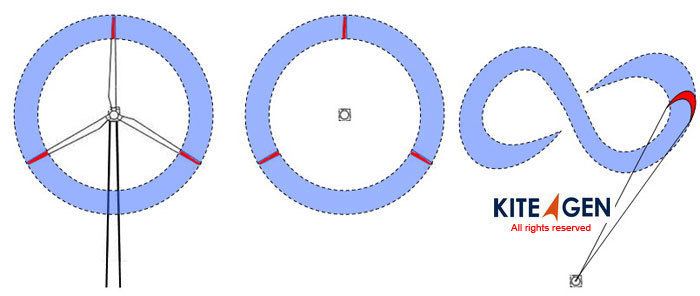Founded 2007 | ||
 | ||
Kitegen stem
KiteGen is a concept developed in Italy for a wind harnessing machine that takes power from high altitude winds. The vertical axis orientation of the rotation is intended to eliminate the static and dynamic problems that prevent the increase in size of conventional wind turbines. The prototype STEM yo-yo is under construction at Berzano di San Pietro in Italy.
Contents
- Kitegen stem
- Kitegen crowdfunding on indiegogo
- History
- KiteGen structure
- Winds of high altitude
- Funding
- Mobilegen
- Aluminium smelter
- References
Kitegen crowdfunding on indiegogo
History
The KiteGen was originally conceived by Italian researcher Massimo Ippolito. While observing kite surfers he noticed the large amount of energy that the kite was able to collect and thought that a similar system could produce electricity. This idea seemed to Ippolito so risky that he put it aside for some years.
KiteGen structure
The problem of "capturing" the wind is solved by the use of Power Wing Profiles (Power kites) whose movements are controlled automatically by a computer. Through cables the kites are anchored to a structure that rotates, generating electricity. This structure is the turbine of the high altitude wind farm while the kites are the "blades" of the turbine.
The kites are flown on a predetermined trajectory, that can transform the exerted force on the cable, to an overall mechanical torque which rotates the vertical axis turbine. About twenty automatically controlled kites can keep rotating a turbine of 1,600 meters diameter at a speed of 15 revolutions per hour. This can generate 1 Gigawatt of power, equivalent to a medium size nuclear power station but with an estimated capital cost 10 times lower. In other words, 1 cubic Km of sky is able to provide 1 GigaWatt of power for 80% of the time in a year.
The kites extra added benefit lies in the fact that the length of cables allows them to reach heights over 500 meters, where the high altitude wind flows, without introducing structural weaknesses.
Winds of high altitude
There are two wind flow bands that envelope the Earth globe. One passes over the southern hemisphere at the latitude of Patagonia, while the other passes over the northern hemisphere, over Europe. The flow height ranges from 800 meters up to 10,000 meters of altitude, while the width is 4,000 or 5,000 km. The average power of the wind is about 2 kW per square meter.
High altitude wind is much more powerful and constant when compared to that at earth level, which is intense in very few places, and at full speed for only about 1,700-1,800 hours per year, which limits the annual production of energy.
The wind which is planned to be used is around 800 meters height with average speeds of 7 m/s and specific power of 200 W/m
The conceptual prototype in the Province of Asti which would work with nine generators and up to 10,000 m alitude would generate a peak power of 27 MW. A park of Kitegens with 100 MW peak power should produce 500 GWh/year; enough for 86,000 households
The Kitegen can generate about 6000 hours / year.
Funding
In June 2006 the Kitegen had been selected to receive public financing from the Italian Ministry for Economic Development. Although the project received a "priority B" score the procedure evaluation was not carried out because of lack of funds. Economic capital, performance evaluation, and capital adequacy is proceeding from evaluator agency (Sanpaolo-Intesa Bank).
Under the 7th Framework Program of the European Union, an elaboration of the project within the transport sector was rated "excellent" and received funding of €3 million for the realization of solutions based on wing profiles for the generation of electricity aboard ships, traction and management of ancillary services (proposal No. 218,691; acronym: "KitVes"). In November 2008, European Union informed that provision of funds will start "soon".
Mobilegen
In August 2006 a prototype of the KiteGen named mobilegen was first tested. This truck mounted system is mobile and uses low-altitude wind. A mobile generator of second generation was tested in September 2007 at Francesco Cappa airport located in Casale Monferrato (Province of Alessandria, Italy). The unit called KSU1 used a kite that flew to 800 meters with automatic controls. The experiments lasted three days and required special permits from civil and military aviation.
Aluminium smelter
In September 2012 KiteGen sent an offer to Italian Government to relieve the aluminium smelter in Portovesme from ALCOA and run it with his wind capturing technologies. Actually the plant is the biggest energy user in Italy with 2.3 Twh/year, so KiteGen think that a farm of 200 generators in only 1 square kilometer near the plant would be able to draw 300 MW of power with a year availability of 5000 hours. All expenses for construction can be write off in nearly 2 years with energy costs around 30 €/Mwh. For comparison Glencore offer for the smelter want to relieve it only if the energy costs can drop to 37 €/Mwh by state aids because high power costs of nearby Sulcis Coal Power Station (around 70 €/Mwh) are the main reason for ALCOA to leave Sardinia.
